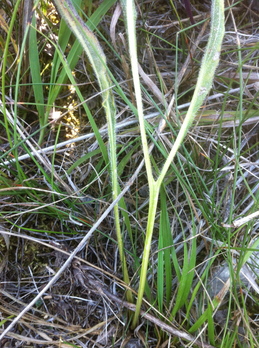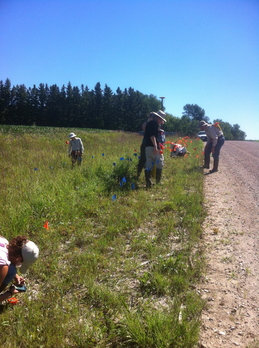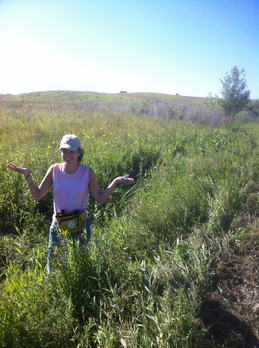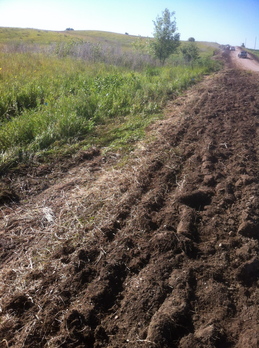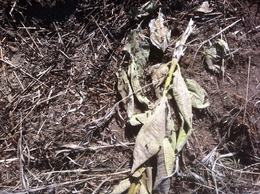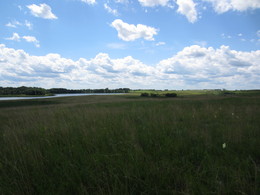|
|
Hi there everyone,
I was an intern with the Echinacea Project last summer (2012) and worked on the remnant flowering phenology project. Over my winter term at Carleton I worked on an independent study to analyze the seed set of some of the remnant plants. After finishing dissection and x-raying the achenes (with a lot of help from the lovely volunteers in Chicago!), I created a poster which I presented at the Midwest Ecology and Evolution Conference in March of this year. I have attached the poster to this post. Hopefully, it explains some cool findings!
Good luck with field work everybody!
kapsar_MEECposter.pdf
This morning, Team Echinacea headed out to Loeffler’s Corner to work on seedling re-finds. This site was a breeze compared with the challenges posed by Riley and KJ’s. While the plants at Riley are frequently disturbed by mowing and the plants at KJ’s are so dense that they’re practically growing on top of each other, the plants at Loeffler’s Corner are nicely spread out with easily findable seedlings.
In the afternoon, everyone made good progress on individual projects. Jill and I are both trying to wrap up our research in time for our last day on Friday. Jill and Katherine are sorting through the contents of Jill’s pitfall traps and preserving the ants that they won’t have time to identify for future study. Stuart and I are working to prepare my data to be analyzed in the winter when I hope to have an independent study to work on analysis. Maria is looking for Dicanthelium plants from which she can gather pollen in order to do a pollen viability test.
Here’s a picture of a neat plant that I found at Loeffler’s Corner. I think the leaves are somehow sharing the same petiole. Pretty cool!

The last flowering plant in CG1 put out its last anthers today (August 27, 2012). It had been flowering over a week longer than any of the other plants we monitor! This marks the end of the flowering season for Team Echinacea, but we’ve still got lots of work left to do!
Happy Friday! Today was our fourth day “going solo” while Stuart is away in Chicago. In the morning, we finished up seedling searches at East Elk Lake Road. That’s two sites down! In the afternoon, we continued working on demography re-checks at some of the smaller sites. Basically, demography re-checks consist of fixing any errors that we might have made during the initial round of demography (i.e. one person said a plant had two heads while another said it had four), but it also allows us to go back and find basal plants that have flowered previously. By checking on these plants (or a random subset of these plants) each year, we can get a better idea of how often a plant flowers and the survival rate of flowering plants. Today we finished demography re-checks at Loeffler’s Corner (East and West) and Yellow Orchid Hill.
Here’s a picture of the crew at Yellow Orchid Hill after a hard day’s work:

Thursday was a cool, beautiful day in Kensington. Our main task this week has been to finish up the first round of demography at all of the remnant prairies. Today Stuart, Gretel, Shona, and I went out to work on some of the smaller remnants (usually <10 flowering plants). Demography is a great way to allow us to keep track of plants over time and monitor the flowering patterns of both individuals and populations.
Katherine and Maria started on Katherine’s last round of ant and aphid surveys in the remnants today. It seems like the peak of aphid season has come and gone, but this last survey should help her determine the rate of decline of aphid populations (and maybe provide hints as to where they all go in the winter!).
After a few mishaps with regard to seedling re-finds (the process of re-finding the seedlings, or “slings”, that have been discovered during Amy’s seedling search experiment), I decided to write a haiku to best express our emotions:
Seedling re-finding
Basals, slings, all on visor?
No one really knows.
Thankfully, Amy and Stuart came through to save the day and we now have a much more firm grasp of our mission. In short:
Slings are important
Basals only if they’re near
Gotta find the slings.
Here’s a picture of a seedling that we found earlier this summer. Take a look at the two green cotyledons at the base of the plant. Cotyledons only appear in a plants first year of growing and are the only way to be sure that a plant is a seedling instead of just a small basal.

Here’s a copy of the poster that I submitted for the poster session at the University of Minnesota. It has some preliminary results as well as a list of future data analysis that I want to complete.
kapsar_UofMPoster.pdf
What a day! The kitchen at Town Hall was busier at 7:20 this morning than I’ve ever seen. It seems like everyone had the same idea to get up early and give their poster one last look before submitting it for printing. Thankfully we all got our posters in on time and we are enjoying a nice reprieve from poster-work this evening.
At work today, we completed demography on East Riley. There were lots and lots of flowering plants within a meter or so of the road that had been mowed and did not get chance to flower this year. In the afternoon, we worked on more demography at East Elk Lake Road and Around Landfill.

In the morning, Stuart told us about some roadwork that was happening along the Douglas-Grant County line by our Landfill sites. Katherine, Jill, and I stopped by to check it out. It looks like the road workers have dug up about 3 meters of roadside along the North-northwest of Landfill site. On the positive side, it’s lucky that this is happening after the plants had finished flowering, but on the negative side, one row of Jill’s pitfall traps have been buried. We met some of the construction workers who told us that they were working to improve the drainage of the road by evening out the roadside ditches. He also showed us the seed they were replanting: a mixture of brome, timothy, alfalfa, and clover among other things.



I guess this is a prime example of the habitat fragmentation and altered disturbance patterns that we’re here to study. It’s hard to watch the plants go, but in the long run these disturbances and our ability to monitor if/how the plants recover will teach us how to better manage prairie remnants in order to maintain stable plant populations.
Today was full of re-checks for Team Echinacea. In the morning we finished re-checking all of the locations in the CG-1 experimental plot where we could not find a plant when we were measuring. If plants are not found for three years in a row, then they are considered to be dead. This means that an empty location gets checked five times before it gets a staple! This procedure allows us to be sure that we aren’t just overlooking a small plant that needs to be measured (small plants have important data too!).
For the remainder of the morning, all of the undergraduates worked hard on preparing for the University of Minnesota Undergraduate Research Poster Session next Thursday. Many of us are working hard to learn R before Monday when our posters have to be submitted. I believe that opinions are still divided with regard to R (although I personally converted back from the dark side after I finally figured out how to make my graphs work!). We’ll report back later with a final opinion.
Since we have been perfecting our re-checking skills in the CG1 experimental plot, Stuart decided we were finally ready to start tackling the CG2 plot at Hegg Lake. Unlike CG1, the Hegg Lake garden does not have nicely mowed rows or staples, which makes it more challenging to measure. However, we did find a fair number of previously overlooked plants this afternoon.

To cool off after work, Stuart bought ice cream and root beer for everyone. We all had ginormous root beer floats while trying to find GRE vocab words that could stump Stuart. I think we failed pretty badly. In the end, 2 liters of soda and 5 quarts of ice cream were consumed and good times were had by all!
Now that Team Echinacea has (finally!) finished measuring plants in CG1, we’ve started a couple of new activities. In the morning a group went into CG1 to place staples at locations where plants have not been found for the past three seasons. These staples help us to keep track of distance between plants when measuring.
In the afternoon, almost everyone went out to the North of Railroad and Railroad sites to work on demography. In brief, demography is a way to keep track of plants in the prairie remnants that Team Echinacea studies by finding and taking the GPS locations of flowering plants every year. By understanding how often plants flower and how often new plants flower for the first time, we can get a better idea of whether or not a population is stable.
As a Flog Post bonus, I’m including some haikus that I wrote yesterday morning when we were trapped indoors by the rain. I’ve written one about each Team Echinacea member’s project this year as well as several more general haikus about what we do. Enjoy!
The Echinacea Project Haikus.doc
Now that the vast majority of Echinacea are finished flowering (except for the populations at Staffanson and one lonely plant at Northwest of Landfill), I’ve started piecing together a master datasheet with the first and last day of flowering for every Echinacea head that I have been studying. Please let me know if you have any comments or recommendations for statistical analysis, possible comparisons to other data sets, or better organizational methods!
phen_mastersheet_2012.csv
phen_mastersheet_2012_metadata.doc
|
|

